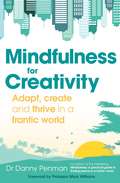- Table View
- List View
Post-Romantic Stress Disorder: What to do when the honeymoon is over
by John BradshawJohn Bradshaw is arguably the most accomplished and well-known leader alive today in the addictions field. He taught us about functional and dysfunctional families, showed us how shame could become toxic and poisonous to our core selves, and helped us understand and heal the wounded, vulnerable 'inner child' conceived by, and thriving in, that environment. In Post-Romantic Stress Disorder (PRSD), John Bradshaw gives readers a clear explanation of the difference between falling in love, lust and true love. Based on his research, PRSD is a serious psychological disorder and the cause of 40 per cent of all divorces - divorces that could have been prevented. Every day people throw away perfectly good relationships because they just don't know how to navigate the tides, but if they could learn and understand the concepts Bradshaw presents in this book, the portrait of the family unit could have a whole new landscape. Join this great teacher as he tackles issues that threaten and endanger so many modern relationships. Be encouraged as he leads the way to a deeper and more fulfilling partnership. As he so eruditely observed some time ago, 'As the health of the marriage goes, so goes the health of the family'. Yet Bradshaw ladles out hope unlimited - if parents could restore a deep, authentic love for each other it could be passed on to their children and relationships and families would flourish.
Living With Angels: Bringing angels into your everyday life
by Theolyn CortensIn this fascinating and informative guide, angel expert Theolyn Cortens helps you to bring angels into your life. Living With Angels offers a practical introduction to angels and how to experience and communicate with them, as well as easy-to-follow exercises on how to contact your guardian angel. You will learn: how to call and work with your guardian angel and the archangel of your zodiac sign; how to call on angels and archangels for specific purposes, including protecting your family, travelling in safety, or nurturing close relationships; how you can work with angels to create a better life for yourself and others
Living With Angels: Bringing angels into your everyday life
by Theolyn CortensLiving With Angels offers a practical introduction to angels and how to experience and communicate with them, as well as easy-to-follow exercises on how to contact your guardian angel. You will learn: how to call and work with your guardian angel and the archangel of your zodiac sign; how to call on angels and archangels for specific purposes, including protecting your family, travelling in safety, or nurturing close relationships; how you can work with angels to create a better life for yourself and others
Cold-Hearted Rake: The Ravenels, Book 1 (The Ravenels #1)
by Lisa Kleypas'I'm just so excited for everyone to discover Cold-Hearted Rake, and for me to read the rest of the Ravenel series!' Sarah MacLeanA twist of fate . . . Devon Ravenel, London's most wickedly charming rake, has just inherited an earldom. But his powerful new rank in society comes with unwanted responsibilities, and more than a few surprises. His estate is saddled with debt, and the late earl's three innocent sisters are still occupying the house . . . along with Kathleen, Lady Trenear, a beautiful young widow whose sharp wit and determination are more than a match for Devon's own. A clash of wills . . . Kathleen knows better than to trust a ruthless scoundrel like Devon. But the fiery attraction between them is impossible to deny - and from the first moment Devon holds her in his arms, he vows to do whatever it takes to possess her. As Kathleen finds herself yielding to his skilfully erotic seduction, only one question remains: Can she keep from surrendering her heart to the most dangerous man she's ever known? 'Kleypas can make you laugh and cry - on the same page' Julia Quinn This is the breath-taking first novel in the Ravenel series by New York Times bestselling author Lisa Kleypas - perfect for fans of Sarah MacLean, Julia Quinn and Eloisa James. The Ravenels: Cold-Hearted Rake Marrying Winterborne Devil in Spring Hello Stranger Devil's Daughter Chasing Cassandra Praise for Lisa Kleypas: 'Intricately and elegantly crafted, intensely romantic . . . A gratifying series starter from a not-to-be-missed romance author' Kirkus Reviews 'Kleypas is an amazing writer. In my opinion, she might be the most technically skilled historical romance author out there' Smart Bitches, Trashy Books 'Insightful characterisation, an abundance of super-charged sexual chemistry, a dash of dry humour, and a to-die-for hero, all of which will have the author's legions of fans giddy with delight at her triumphant return to historical romance' Booklist '[An] addictive, rewarding story . . This delightful, compelling story is the first in Kleypas's new Victorian series about the Ravenel family' Library Journal 'Readers are introduced to the unforgettable characters and their original personalities through a delightful storyline peppered with sharp repartee and steamy sensuality' RT Book Reviews (top pick) 'Cold-Hearted Rake brings to mind some of the best elements of her Hathaway, Wallflower, Gambler, and Capital Theatre series novels.... Reading Kleypas' long-awaited return to historical is akin to walking into the arms of an old friend' Heroes and Heartbreakers
Marrying Winterborne (The Ravenels #2)
by Lisa KleypasWINNER OF THE ROMANTIC TIMES BOOK OF THE YEAR AWARDNew York Times bestselling author Lisa Kleypas returns with the second dazzling romance in the Ravenels series - perfect for fans of Sarah MacLean, Julia Quinn and Eloisa James. In her stunning novel, one of the realm's most powerful men meets his match - in his lovely, innocent new wife. 'Lisa Kleypas is the best' Sarah MacLean A ruthless tycoon . . . Savage ambition has brought common-born Rhys Winterborne vast wealth and success. In business and beyond, Rhys gets exactly what he wants. And from the moment he meets the shy, aristocratic Lady Helen Ravenel, he is determined to possess her. If he must take her virtue to ensure she marries him, so much the better . . . A sheltered beauty . . . Helen has had little contact with the glittering, cynical world of London society. Yet Rhys's determined seduction awakens an intense mutual passion. Helen's gentle upbringing belies a stubborn conviction that only she can tame her unruly husband. As Rhys's enemies conspire against them, Helen must trust him with her darkest secret. The risks are unthinkable . . . the reward, a lifetime of incomparable bliss. And it all begins with . . . Marrying Winterborne. 'Kleypas can make you laugh and cry - on the same page' Julia Quinn The Ravenels: Cold-Hearted Rake Marrying Winterborne Devil in Spring Hello Stranger Devil's Daughter Chasing Cassandra Praise for Lisa Kleypas: 'Intricately and elegantly crafted, intensely romantic . . . from a not-to-be-missed romance author' Kirkus Reviews'Witty, often hilarious, and delightfully passionate, this compelling, thrill-laced Victorian romance is another superb series entry' Library Journal, starred review'Readers are introduced to the unforgettable characters and their original personalities through a delightful storyline peppered with sharp repartee and steamy sensuality' RT Book Reviews (top pick)'Is it possible to give a book 6 stars? . . . [This] story has all of the forbidden romance, witty banter, and sigh-inducing declarations of love that you deserve' That's Normal
Devil in Spring (The Ravenels #3)
by Lisa KleypasNew York Times bestselling author Lisa Kleypas delivers the unforgettable tale of a strong-willed beauty who encounters her match in one of London's most notorious-yet irresistible-rakes . . . perfect for fans of Sarah MacLean, Julia Quinn and Eloisa James. 'Lisa Kleypas is the best' Sarah MacLean An eccentric wallflower . . . Most debutantes dream of finding a husband. Lady Pandora Ravenel has different plans. The ambitious young beauty would much rather stay at home and plot out her new board game business than take part in the London Season. But one night at a glittering society ball, she's ensnared in a scandal with a wickedly handsome stranger. A cynical rake . . . After years of evading marital traps with ease, Gabriel, Lord St. Vincent, has finally been caught by a rebellious girl who couldn't be less suitable. In fact, she wants nothing to do with him. But Gabriel finds the high-spirited Pandora irresistible. He'll do whatever it takes to possess her, even if their marriage of convenience turns out to be the devil's own bargain. A perilous plot . . . After succumbing to Gabriel's skilled and sensuous persuasion, Pandora agrees to become his bride. But soon she discovers that her entrepreneurial endeavours have accidentally involved her in a dangerous conspiracy - and only her husband can keep her safe. As Gabriel protects her from their unknown adversaries, they realise their devil's bargain may just turn out to be a match made in heaven... 'Kleypas can make you laugh and cry - on the same page' Julia Quinn The Ravenels: Cold-Hearted Rake Marrying Winterborne Devil in Spring Hello Stranger Devil's Daughter Chasing Cassandra Praise for Lisa Kleypas: 'Intricately and elegantly crafted, intensely romantic . . . from a not-to-be-missed romance author' Kirkus Reviews'Witty, often hilarious, and delightfully passionate, this compelling, thrill-laced Victorian romance is another superb series entry' Library Journal, starred review'Readers are introduced to the unforgettable characters and their original personalities through a delightful storyline peppered with sharp repartee and steamy sensuality' RT Book Reviews (top pick)'Is it possible to give a book 6 stars? . . . [This] story has all of the forbidden romance, witty banter, and sigh-inducing declarations of love that you deserve' That's Normal
Hello Stranger (The Ravenels #4)
by Lisa KleypasNew York Times bestselling author Lisa Kleypas delivers a scintillating tale of an unconventional beauty who finds passion with the spy who can't resist her - perfect for fans of Sarah MacLean, Julia Quinn and Eloisa James. 'Lisa Kleypas is the best' Sarah MacLean A woman who defies her time . . . Dr. Garrett Gibson, the only female physician in England, is as daring and independent as any man - why not take her pleasures like one? Yet she has never been tempted to embark on an affair, until now. Ethan Ransom, a former detective for Scotland Yard, is as gallant as he is secretive, a rumoured assassin whose true loyalties are a mystery. For one exhilarating night, they give in to their potent attraction before becoming strangers again. A man who breaks every rule . . . As a Ravenel by-blow spurned by his father, Ethan has little interest in polite society, yet he is captivated by the bold and beautiful Garrett. Despite their vow to resist each other after that sublime night, she is soon drawn into his most dangerous assignment yet. When the mission goes wrong, it will take all of Garrett's skill and courage to save him. As they face the menace of a treacherous government plot, Ethan is willing to take any risk for the love of the most extraordinary woman he's ever known. 'Kleypas can make you laugh and cry - on the same page' Julia Quinn The Ravenels: Cold-Hearted Rake Marrying Winterborne Devil in Spring Hello Stranger Devil's Daughter Chasing Cassandra Praise for Lisa Kleypas: 'Intricately and elegantly crafted, intensely romantic . . . from a not-to-be-missed romance author' Kirkus Reviews'Witty, often hilarious, and delightfully passionate, this compelling, thrill-laced Victorian romance is another superb series entry' Library Journal, starred review'Readers are introduced to the unforgettable characters and their original personalities through a delightful storyline peppered with sharp repartee and steamy sensuality' RT Book Reviews (top pick)'Is it possible to give a book 6 stars? . . . [This] story has all of the forbidden romance, witty banter, and sigh-inducing declarations of love that you deserve' That's Normal
Devil's Daughter (The Ravenels #5)
by Lisa KleypasNew York Times bestselling author Lisa Kleypas delivers a scintillating tale of a beautiful young widow who finds passion with the one man she shouldn't . . . perfect for fans of Sarah MacLean, Julia Quinn and Eloisa James. 'Lisa Kleypas is the best' Sarah MacLean Although beautiful young widow Phoebe, Lady Clare, has never met West Ravenel, she knows one thing for certain: he's a mean, rotten bully. Back in boarding school, he made her late husband's life a misery, and she'll never forgive him for it. But when Phoebe attends a family wedding, she encounters a dashing and impossibly charming stranger who sends a fire-and-ice jolt of attraction through her. And then he introduces himself . . . as none other than West Ravenel. West is a man with a tarnished past. No apologies, no excuses. However, from the moment he meets Phoebe, West is consumed by irresistible desire . . . not to mention the bitter awareness that a woman like her is far out of his reach. What West doesn't bargain on is that Phoebe is no straitlaced aristocratic lady. She's the daughter of a strong-willed Wallflower who long ago eloped with Sebastian, Lord St. Vincent - the most devilishly wicked rake in England. Before long, Phoebe sets out to seduce the man who has awakened her fiery nature and shown her unimaginable pleasure. Will their overwhelming passion be enough to overcome the obstacles of the past? Only the devil's daughter knows . . . 'Kleypas can make you laugh and cry - on the same page' Julia Quinn The Ravenels: Cold-Hearted Rake Marrying Winterborne Devil in Spring Hello Stranger Devil's Daughter Chasing Cassandra Praise for Lisa Kleypas: 'Is it possible to give a book 6 stars? If so, Devil's Daughter gets them . . . [This] story has all of the forbidden romance, witty banter, and sigh-inducing declarations of love that you deserve' That's Normal 'Devil's Daughter is a must read' BookPage 'A love story to savour. Another winner in Kleypas' Ravenels series, with elegant prose, a fascinating heroine, and a Victorian London constructed with compelling historical detail' Kirkus Reviews (starred review)'Witty, often hilarious, and delightfully passionate, this compelling, thrill-laced Victorian romance is another superb series entry' Library Journal, starred review'Readers are introduced to the unforgettable characters and their original personalities through a delightful storyline peppered with sharp repartee and steamy sensuality' RT Book Reviews (top pick)
Chasing Cassandra: an irresistible new historical romance and New York Times bestseller (The Ravenels #6)
by Lisa KleypasA New York Times bestseller! New York Times bestselling author Lisa Kleypas returns with the next dazzling romance in the Ravenels series - perfect for fans of Sarah MacLean, Julia Quinn and Eloisa James. 'Lisa Kleypas is the best' Sarah MacLean Everything has a price . . .Railway magnate Tom Severin is wealthy and powerful enough to satisfy any desire as soon as it arises. It should be simple to find the perfect wife - and from his first glimpse of Lady Cassandra Ravenel, he's determined to have her. But the beautiful and quick-witted Cassandra is equally determined to marry for love - the one thing he can't give.Everything except her . . .Severin is the most compelling and attractive man Cassandra has ever met, even if his heart is frozen. But she has no interest in living in the fast-paced world of a ruthless man who always plays to win. When a newfound enemy nearly destroys Cassandra's reputation, Severin seizes the opportunity he's been waiting for. As always, he gets what he wants - or does he? There's one lesson Tom Severin has yet to learn from his new bride:Never underestimate a Ravenel.The chase for Cassandra's hand may be over. But the chase for her heart has only just begun . . . 'Kleypas can make you laugh and cry - on the same page' Julia Quinn The Ravenels: Cold-Hearted Rake Marrying Winterborne Devil in Spring Hello Stranger Devil's Daughter Chasing Cassandra Praise for Lisa Kleypas:'Opposites attract in spectacular fashion in the sixth Victorian-era Romance in bestseller Kleypas's Ravenel series' Publishers Weekly (starred review)'Intricately and elegantly crafted, intensely romantic . . . from a not-to-be-missed romance author' Kirkus Reviews'Witty, often hilarious, and delightfully passionate, this compelling, thrill-laced Victorian romance is another superb series entry' Library Journal, starred review'Readers are introduced to the unforgettable characters and their original personalities through a delightful storyline peppered with sharp repartee and steamy sensuality' RT Book Reviews (top pick)'Is it possible to give a book 6 stars? . . . [This] story has all of the forbidden romance, witty banter, and sigh-inducing declarations of love that you deserve' That's Normal
Devil in Disguise
by Lisa KleypasNew York Times bestseller Lisa Kleypas returns with an enthralling and steaming romance between a widowed lady and a Scot on the run. Perfect for fans of Sarah MacLean, Julia Quinn and Eloisa James. 'Lisa Kleypas is the best' SARAH MACLEAN Lady Merritt Sterling, a strong-willed young widow who's running her late husband's shipping company, knows London society is dying to catch her in a scandal. So far, she's been too smart to provide them with one. But then she meets Keir MacRae, a rough-and-rugged Scottish whisky distiller, and all her sensible plans vanish like smoke. They couldn't be more different, but their attraction is powerful, raw and irresistible.From the moment Keir MacRae arrives in London, he has two goals. One: don't fall in love with the dazzling Lady Merritt Sterling. Two: avoid being killed.So far, neither of those is going well.Keir doesn't know why someone wants him dead until fate reveals his secret connection to one of England's most powerful families. His world is thrown into upheaval, and the only one he trusts is Merritt.Their passion blazes with an intensity Merritt has never known before, making her long for the one thing she can't have from Keir MacRae: forever. As danger draws closer, she'll do whatever it takes to save the man she loves . . . even knowing he might be the devil in disguise.Praise for Lisa Kleypas 'Kleypas can make you laugh and cry . . . on the same page' JULIA QUINN
The Obsession
by Nora RobertsIn this spellbinding novel about a woman whose past is catching up with her, #1 New York Times bestselling author Nora Roberts dazzles readers 'a story you won't be able to put down' (Library Journal)Naomi Carson is a survivor. As a child, her family was torn apart by a shocking crime. It could have destroyed her, but Naomi has grown up strong, with a passion for photography that has taken her all around the world.Now, at last, she has decided to put down roots. The beautiful old house on Point Bluff needs work, but Naomi is looking forward to making a home of her own.But as Naomi plans for the future, her past is catching up with her. Someone in town knows her terrifying secret - and won't let her forget it... 'A read to be savored . . . Roberts has an unparalleled ability to paint a picture with words . . . and the story is expertly executed.' -Publishers Weekly (starred review)
Stars of Fortune (Guardians Trilogy #1)
by Nora RobertsSasha Riggs is a reclusive artist, haunted by vivid dreams that she turns into extraordinary paintings. Desperate to understand her visions, she finds herself drawn to the Greek island of Corfu. She has only just arrived when she encounters Bran Killian, an Irish magician with a warm charisma and secrets dancing in his eyes. Sasha has never met Bran before, but she knows him only too well - because this is the man from her dreams. The man she seems fated to be with...if she can find the courage to accept who she really is.Sasha soon discovers that four other strangers have been lured to the island. Like Bran, they are all searching for a mysterious jewel known as the fire star - before it falls into the wrong hands. Together, they might just succeed. But first they must learn to trust one another, and reveal their deepest secrets.On the sun-drenched island of Corfu, love and magic are sparked into life. And for Sasha, nothing will ever be the same again.
Bay of Sighs (Guardians Trilogy #2)
by Nora RobertsA dark and powerful goddess hunts for three jewels: fallen stars that will give her endless power. To save the world, six friends have joined forces to stop her. Now, on the beautiful island of Capri, their battle continues...Mermaid Annika is proud to have been chosen for such an important quest. But now that her identity has been revealed, her time is running out. She knows that soon she must return to her people. But she also knows that she is in love with Sawyer King - the brave and loyal adventurer with secrets of his own. As Annika, Sawyer and their four friends hunt for the mysterious 'star of water', the goddess Nerezza sends a terrifying foe to destroy them. It seems there is no place for love and desire at such a dark time. And so Sawyer tries to protect Annika by pushing her away. But true love cannot be denied. And in a battle between the dark and the light - it might be the only thing that can save them from a terrible fate.
Island of Glass (Guardians Trilogy #3)
by Nora RobertsA vengeful goddess hunts for three jewels: fallen stars that will give her endless power. To save the world, six friends have joined forces to stop her. Now, on the wild and beautiful coast of County Clare, their battle reaches its dramatic climax. Doyle Mac Cleirich - soldier and reluctant immortal - has always vowed never to return home. But when his search for the final star leads him to Ireland, it becomes clear that fate has other plans.Solitary by inclination, Doyle is also fighting his growing attraction to archaeologist Riley. His warrior spirit is drawn to the wild - and there's no one more familiar with the wild than Riley. As the six guardians face their final challenge, Riley and Doyle are prepared to risk their lives in battle. But without love to sustain them, the quest is doomed to failure...
Private Scandals
by Nora RobertsDeanna Reynolds has everything mapped out: her dream job, her dream life. A talented TV journalist, she is determined to make it big on her own terms. But in a world of public smiles and private feuds, Deanna has attracted some dangerous enemies - including her old mentor, the brilliant but emotionally manipulative Angela Perkins.As Deanna's star rises, she is flung together with Finn Riley, the network's most charismatic journalist. Finn is instantly attracted to Dee - but he is also Angela's ex-lover. As sparks fly between Finn and Deanna, Angela plots her revenge. But there is an even darker obsession growing in the shadows - and no one is safe.Filled with intense passions, dark obsessions and bitter feuds, Private Scandals is pure, addictive pleasure.
Hidden Riches
by Nora RobertsCreative and spontaneous, antiques dealer Dora Conroy has an infectious enthusiasm for life. She also has an eye for quality, and her gorgeous shop in Philadelphia is overflowing with fascinating finds. But when - on impulse - she buys a few curiosities at auction, she gets a lot more than she bargained for. Because Dora doesn't realise she has brought home a priceless cache of treasure: a collection that one ruthless criminal is determined to make his own - whatever the cost . . .Caught up in a deadly chase, Dora turns in desperation to her new neighbour, ex-cop Jed Skimmerhorn. Jed, struggling with a personal tragedy, has no wish to jump back into the line of fire. But there is something irresistible about Dora . . . As Jed and Dora fight their growing attraction, they must work out what they value the most, before it's too late.
True Betrayals
by Nora RobertsDear Kelsey: I realise you might be surprised to hear from me . . .Kelsey Byden, divorced at just twenty-six, isn't looking for any more drama. But then she receives a letter from her mother, Naomi. Not so unusual - except Kelsey has always been told that Naomi was dead . . .During an extended visit to her mother's beautiful horse farm in Virginia, Kelsey begins to untangle a lifetime of deception. Who can she trust, when those she loves have lied to her for so long? To complicate things further, Kelsey is falling dangerously in love with Gabe Slater, Naomi's handsome and intriguing neighbour. But love and lies are a lethal combination. If Kelsey has any hope of a future with Gabe, she must first understand the terrible truth about her past . . .
Genuine Lies
by Nora RobertsEve Benedict is a legend: a movie goddess with two Oscars, four ex-husbands and a legion of lovers to her name. She knows the truth behind every Hollywood scandal - and now she's planning to tell all in a no-holds-barred memoir. But telling the truth can be a dangerous business, especially in a town built on dreams and secrets. Eve's stepson Paul Winthrop is worried that the book will only bring trouble. But he can't argue with Eve's choice of ghostwriter, the talented and very beautiful Julia Summers. As Paul and Julia clash over Eve's book, they also have to fight a deep and growing attraction to each other. Struggling against their intense feelings, they don't realise they are also tangled in a very dark plot. Eve has one last, great secret to reveal - and it will put them all in danger . . .
Carnal Innocence: A Long Hot Summer Of Love, Desire . . . And Murder
by Nora RobertsA retreat to the bayou for some rest and relaxation becomes anything but for celebrated concert violinist Caroline Waverly as she finds herself falling in love . . . with a man who may be a serial killer in this novel from 'the greatest novelist on Planet Earth' (Washington Post)Burned out by a whirlwind musical career, Caroline Waverly arrives in the small Mississippi town of Innocence desperate for some peace and quiet.Relaxing in her grandmother's beautiful home by the bayou, Caroline has no intention of indulging in a summer fling . . . until she meets Tucker Longstreet. Tucker has a reputation for keeping his romances short and shallow, but this feels different for both of them. Perhaps they might both have a chance for real, lasting love.But then Caroline's quiet summer is shattered by tragedy. A killer is stalking the town, targeting young women. Worse still, evidence seems to point to Tucker himself. And the remote town of Innocence isn't quite as safe and sleepy as it seems . . .
Honest Illusions
by Nora RobertsRoxy Nouvelle understands the art of deception. The daughter of a world-renowned magician, Roxy has inherited her father's talents - and his secret life as a jewel thief. She loves the thrill of the game and can take care of herself.Roxy is smart and resilient, but she has one weakness: Luke Callahan, a sexy escape artist with a roguish reputation. Five years ago they fell into a passionate affair - but then, true to his art - he disappeared, leaving Roxy broken hearted and furious.Now Luke is back, trailing secrets and danger in his wake. Why did he run out on Roxy all those years ago? And can she ever trust him again?
The Art of Asking: How I learned to stop worrying and let people help
by Amanda PalmerREDISCOVER THE FORGOTTEN ART OF ASKING IN THIS NEW YORK TIMES BESTSELLING BOOK 'Amanda Palmer joyfully shows a generation how to change their lives' Caitlin Moran'To read Amanda Palmer's remarkable memoir about asking and giving is to tumble headlong into her world' Elizabeth Gilbert'The Art of Asking is a book about cultivating trust and getting as close as possible to love, vulnerability, and connection. Uncomfortably close. Dangerously close. Beautifully close' Brene BrownImagine standing on a box in the middle of a busy city, dressed as a white-faced bride, and silently using your eyes to ask people for money. Or touring Europe in a punk cabaret band, and finding a place to sleep each night by reaching out to strangers on Twitter. For Amanda Palmer, actions like these have gone beyond satisfying her basic needs for food and shelter - they've taught her how to turn strangers into friends, build communities, and discover her own giving impulses. And because she had learned how to ask, she was able to go to the world to ask for the money to make a new album and tour with it, and to raise over a million dollars in a month.In the New York TImes bestseller The Art of Asking, Palmer expands upon her popular TED talk to reveal how ordinary people, those of us without thousands of Twitter followers and adoring fans, can use these same principles in our own lives.
The Quality of Silence: The Richard and Judy and Sunday Times bestseller
by Rosamund LuptonSunday Times Top-Ten Bestseller and Richard and Judy Book Club Choice.'An elegant and icily unique thriller: you won't read anything like it this year' Observer'Scary, suspenseful and so exquisitely, evocatively written. Everything you want in a wonderful novel' Liane MoriartyI'll risk my life for you.On 24 November Yasmin and her ten-year-old daughter Ruby set off on a journey across Northern Alaska. They're searching for Ruby's father, missing in the arctic wilderness.More isolated with each frozen mile they cover, they travel deeper into an endless night. And Ruby, deaf since birth, must brave the darkness where sight cannot guide her.She won't abandon her father. But winter has tightened its grip, and there is somebody out there who wants to stop them.Somebody tracking them through the dark.Praise for The Quality of Silence:'There are many things to love about Lupton's third novel, not least its stunning evocation of the stark, beautiful Alaskan wilds. An elegant and icily unique thriller: you won't read anything like it this year' Observer'Scary, suspenseful and so exquisitely, evocatively written. I found myself shivering as if I were there in Alaska with Ruby and her mother. Everything you want in a wonderful novel' Liane Moriarty, author of The Husband's Secret'Ambitious and imaginative. Narrated in part by Ruby (her deafness is treated with great sensitivity), the landscape, wildlife and bitter climate of Alaska are powerfully drawn. Chilling in every sense, you won't want to step away from this story' Sunday Mirror'A sophisticated thriller which brilliantly evokes the sublime and terrifying landscape of Alaska, the culture of the Inupiat people and the fragility of our planet' Sunday Telegraph'Like a breath of icy air, this relentlessly tense thriller is also a child's-eye family drama like none other. Not since Miss Smilla's Feeling for Snow have I shivered like this' Emma Donoghue, author of Room'Will have you gripped form start to finish' Cosmopolitan'A taut psychological thriller, The Quality of Silence will have your heart thumping. Masterful pacing, riveting plotting. Absolutely gripping' Louise Penny'A literary slow burn, whose focus is as much on human endurance and a mother's relationship with her deaf daughter as the mystery of her husband's disappearance. This is Lupton at the height of her storytelling powers' Daily Mail'An eerie eco-tale of disasters both real and man-made on the frozen tundra of Alaska. Yasmin and her daughter embark on what becomes an epic journey into the wilderness, [and] the alternating voices of mother and daughter are so compelling, it's hard not to want to go along for the ride. The temperature drops, the action heats up and the suspense builds with the storm. Even a white-out can't hide the darkness within' Vanessa Friedman, NY Times'A beautifully written thriller, and the way in which Lupton used the tundra as a metaphor for grief and faith in stunning. The voice of Ruby and her compassionate exploration of a life without sound only adds to the richness of the book' Press and Journal'A wonderful writer . . . absolutely gripping' Jane Garvey, BBC Radio 2 Women's Hour'The pressure is on to keep creating equally brilliant stores [and] Lupton has done that with The Quality of Silence' Red Magazine'An elegant, chilling read from a writer who continues to stretch the bounds of suspense' William Landay, author of Defending Jacob
Echoes of Scotland Street (On Dublin Street #5)
by Samantha YoungFrom the bestselling author of On Dublin Street, 'Scotland's EL James' (Sunday Post) comes a seductive story of forgiving the past and making up for lost time....Shannon MacLeod has always gone for the wrong type of man. After she drifted from one toxic relationship to the next, her last boyfriend gave her a wake-up call in the worst possible way. With her world shattered, she's sworn off men - especially those of the bad-boy variety.Cole Walker is exactly the sort that Shannon wants to avoid - gorgeous, tattooed, charming, and cocky. But his rough exterior hides a good man - one who's determined to pull Shannon from her self-imposed solitude and win her heart.As Shannon begins to open up, the passion between them ignites to blazing levels. But when her past comes back to haunt her, her fears may destroy the trust Cole has built between them - and tear them apart for good . . . '[The] On Dublin Street series is a total winner' - Dear AuthorWatch the trailer here: https://www.youtube.com/watch?v=lEUzg-9V4-k
The Sell: The secrets of selling anything to anyone
by Bruce Littlefield Fredrik Eklund'With The Sell, Fredrik Eklund has created the modern day How to Win Friends and Influence People. If you're looking for how to achieve success in the 21st century, the answer is in your hands' Tom Doctoroff, CEO, J. Walter Thompson, and author of Twitter is Not a StrategyJust over a decade ago, Fredrik Eklund moved to New York City from his native Sweden with nothing but a worn-out pair of sneakers and a dream: to make it big in the city that never sleeps. Despite having no experience in real estate and no contacts, Fredrik transformed himself into the best seller in the most competitive real estate market on the planet, brokering multimillion-dollar deals for celebrities, selling out properties all over the city and charming TV audiences as one of the stars of Million Dollar Listing New York.Blending personal stories and the expertise he's gained from his meteoric rise, The Sell is the modern guide to becoming successful. Featuring everything from the importance of intangible factors like personality and charm, to tips and tricks for preparing, persuading and negotiating, The Sell is a vital go-to book for anyone who wants to have an impact in his or her personal and professional life. No matter what your background is - sales rep, CEO or kitchen-table entrepreneur - this book will help you sell yourself or your brand, and lead a richer, more fulfilling life.
Mindfulness for a More Creative Life: Calm your busy mind, enhance your creativity and find a happier way of living
by Dr Danny PenmanWork deadlines, to-do lists, family commitments, pressure to perform... Our frantic lives demand so much from us that we can often feel locked into a cycle of frustration, anxiety and stress, unable to tackle the tasks before us or see a way out of our habitual ways of thinking and doing things. Yet there is a way out. The simple mindfulness techniques at the heart of this book can help us lead a more creative and productive life - one that is isn't governed by the chaotic pace of life. They also dissolve anxiety, stress and depression while enhancing mental resilience. The four week programme takes just 10-20 minutes per day.The easy-to-follow programme works by soothing and clearing your mind, allowing innovative ideas to take form and crystallise. This helps you to spontaneously 'see' the solution to a problem, to conjure up new ideas, or to create works that have true insight and flair. The programme helps build the courage necessary for you to follow your ideas wherever they should lead - and the resilience to cope with any setbacks. It will help your mind work more effectively so that you canlive more intuitively and have the inner confidence to drive your ideas forward. The accompanying download link contains 6 meditations that you can use to build an ongoing practice, mixing and matching meditations to suit your circumstances























